Throughout the past couple of years, I have been focusing on my Dividend Growth Portfolio’s smaller positions. I define “small” as a position less than 3% of the total portfolio.
Through dividend reinvestments into those positions, plus using money from a couple of sales earlier in the year, in 2023 I have grown two small positions to the 3% mark or more.
- Evergy (EVRG), a utility – now 3.1% of the portfolio
- Crown Castle (CCI), a cell tower/small cell REIT – now 3.8%
That leaves 12 small positions remaining at under 3% out of 29 positions altogether. I intend to continue focusing on the small ones. I want to verify which ones deserve to remain in the portfolio and which ones do not. I plan to build the former to full position size, and to sell the latter.
This being December, I decided to see whether I could snag a few extra dividend bucks for 2023 by using a month’s worth of accumulated dividends to buy shares of a small position that still has its ex-dividend date to come in December and will also pay in December.
That condition exists for only one stock, and it turned out to be a perfect reinvestment to end the year.
December’s Dividend Reinvestment
The stock for December is the portfolio’s only ETF: Schwab U.S. Dividend Equity ETF (SCHD).
I have rated dividend-oriented ETFs several times, and SCHD has come out on top every time. That means it is right for me; it may not be right for you.
My ratings focus mostly on dividend-growth performance, and SCHD has excelled on that every year since it was introduced in 2011.
My rating factors for sizing up dividend funds include:
- Dividend Growth Streak – how long the fund has increased its dividend annually; longer is better
- Yield – higher is better
- Dividend Growth Rate – faster is better
- Dividend Cuts – how many times the fund has cut its annual dividend; zero is best
- Expense Ratio – lower is better
- Morningstar Fund Rating – Gold, Silver, Bronze, or unrated; Gold is best
SCHD’s record on these metrics is stellar:
- Dividend growth streak: 11 straight years (every year since inception), with 2023 still to be determined when the December payout is declared
- Yield: 3.6%, which is higher than most non-specialized dividend ETFs
- Dividend Growth Rate: 14% per year over the past five years, with 2023 pending
- Dividend Cuts: SCHD has never cut its dividend from one year to the next, with 2023 pending
- Expense ratio: SCHD’s is very low at 0.06%
- Morningstar Fund Rating: Gold (highest)
SCHD pays dividends quarterly, and its declaration for the December payout is expected in about a week. Once that is declared, we will know whether SCHD has extended its dividend increase streak for another year.
Given all of SCHD’s fine characteristics as a dividend-growth investment, the only remaining step is to judge its valuation. Judging the valuations of ETFs can be involved, because they are really a function of the valuations of all of the stocks in the fund. SCHD holds 100 stocks.
For valuing funds, I usually lean on the yield metric, which means that I compare the fund’s current yield to it 5-year average yield. Here is SCHD’s yield over the past five years.
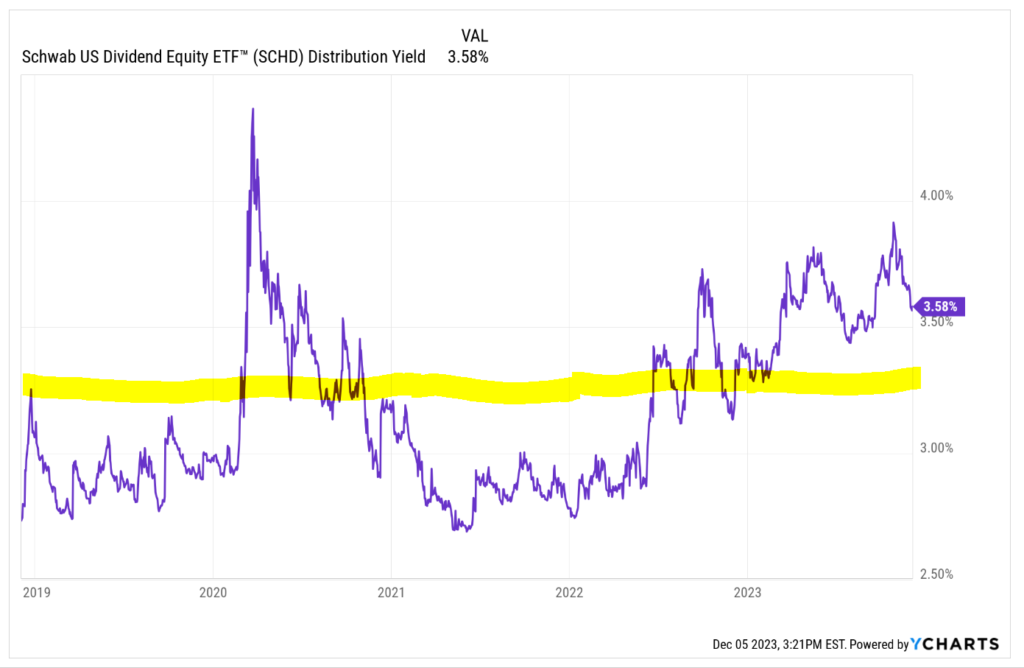 Source: YCharts
Source: YCharts
The purple line in the chart shows SCHD’s yield. The yellow stripe is my eyeball estimate of the average across the chart. Obviously, that is not precise, but it is good enough for my purposes.
The average looks like it has been around 3.25%, while SCHD’s current yield is 3.58%. That would suggest that SCHD is about 9% undervalued at the moment. That is a nice value for this high-quality ETF.
So on Monday, December 4, 2023, I reinvested my accumulated dividends to buy as many SCHD shares as I could afford.
 December Portfolio Review
December Portfolio Review
Now let’s move to a wide-angle lens and look at the whole portfolio.
This month’s purchase of SCHD is my last dividend reinvestment of the year. The following graphic shows how the reinvestment program has gone in 2023.
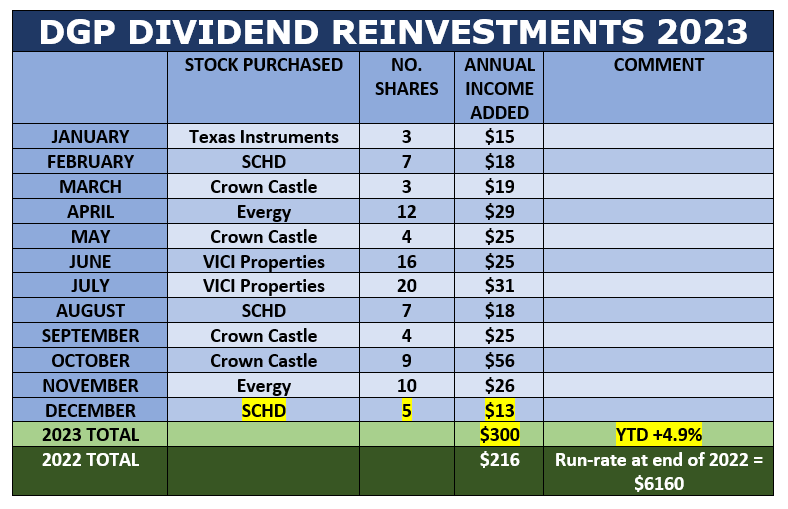 December’s reinvestment, plus 2023’s totals, are highlighted at the bottom.
December’s reinvestment, plus 2023’s totals, are highlighted at the bottom.
This year, I made multiple reinvestments in SCHD, Evergy, Crown Castle, and VICI Properties (VICI). All are small positions that I have been building. Last month’s purchase of Evergy vaulted it out of the small-position category.
As you can see, my reinvestments this year have added $300, or 4.9% compared to 2022, to the annual dividend run-rate.
Dividend reinvestments are the very definition of compounding, which means making money on money already earned. The monthly reinvestment of dividends in this portfolio has added almost 5% to the portfolio’s dividend growth rate.
Dividend reinvestments are not the only process by which dividends grow in a dividend-growth portfolio. Dividend raises by the companies are also a major factor.
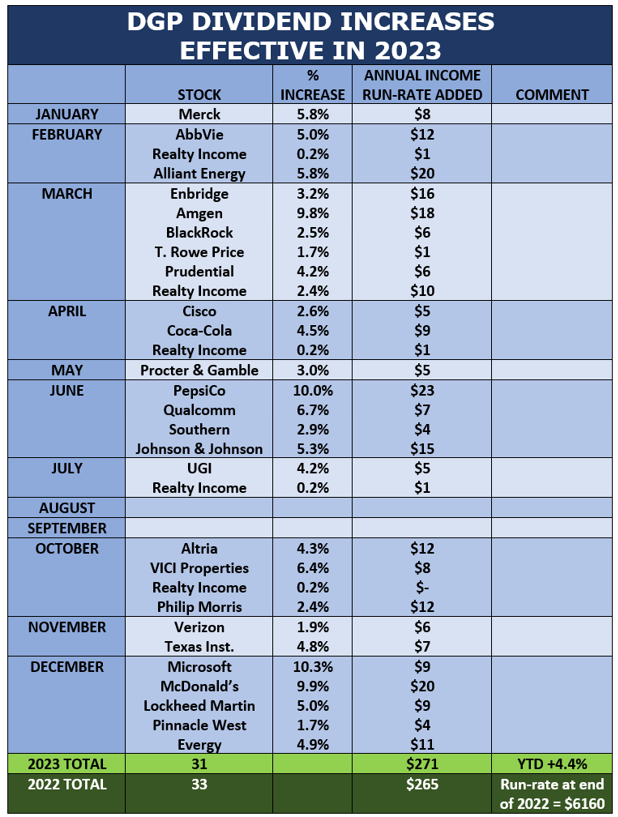 There were no new increases effective in 2023 announced since last month’s report, so nothing is highlighted in yellow.
There were no new increases effective in 2023 announced since last month’s report, so nothing is highlighted in yellow.
As explained earlier, there may be one more increase effective in 2023 – SCHD itself – which will be known when SCHD announces its December dividend payout in a few days.
As things stand now, dividend increases by the companies in the portfolio have added $271, or 4.4%, to the annual dividend run-rate.
The third process by which dividends go up in this portfolio is that, from time to time, I make changes to the portfolio. These are one-off portfolio management moves. The reason for a change might be to trim or sell a disappointing stock, trim a position that has become oversized, and so on.
Some individual trades and adjustments reduce the income stream, but overall, portfolio adjustments tend to increase the income stream on a long-term basis.
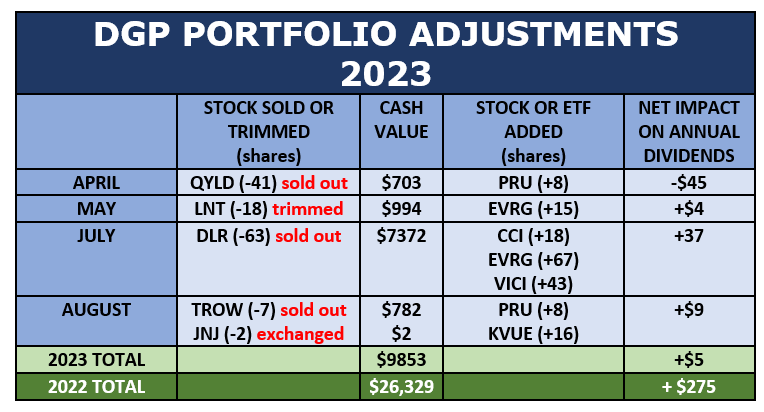 The above table shows the changes that I made in 2023. I turned over less than 6% of the portfolio. The net effect on the portfolio’s income was less than 1% (+$5 per year).
The above table shows the changes that I made in 2023. I turned over less than 6% of the portfolio. The net effect on the portfolio’s income was less than 1% (+$5 per year).
Looking forward to next year, this is my watch list for possible future changes.
 Income Growth Record
Income Growth Record
The primary goal of the DGP is to build a reliable, steadily increasing stream of dividends over the long term. That goal has been, and continues to be, achieved, as shown here:
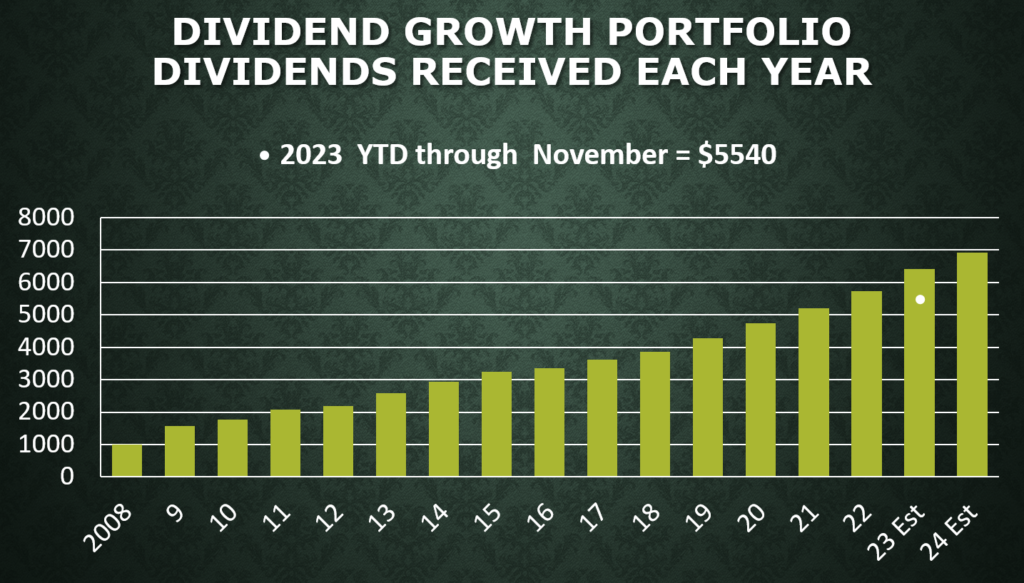 Source: Author
Source: Author
The full-year 2023 estimate – the first year to top $6000 – is the sum of dividends already collected through November plus dividends expected in December.
Through the end of November, I have collected 10.1% more dividends than last year through the same time. The long-term CAGR of the annual dividends (2009-2022) has been 10.4% per year.
The 2024 estimate is simply the 2023 estimate plus 9% as a SWAG. That seems conservative based on the portfolio’s history.
The full portfolio is always available here. You will find an alphabetical list, with yields, position sizes, and other common statistics. That page also contains a complete archive of articles that I have written about the portfolio for this publisher.
History of the DGP
My Dividend Growth Portfolio (DGP) is now in its 16th year. The DGP is real, meaning that it is not hypothetical, a “model,” or a back-test. All decisions about managing it have been made in real time with real money. No new money has been added to the DGP since its inception in 2008.
 Source: Author
Source: Author
That wraps things up for this month. Thanks for reading!
-–Dave Van Knapp
All you have to do is own a small handful of these unique stocks... [sponsor]And you could make more money in 2023 than you would by trading, chasing the latest "hot" stock, or doing anything your broker tells you. Get the details here - including the name of my #1 stock.
Source: Dividends & Income

 December Portfolio Review
December Portfolio Review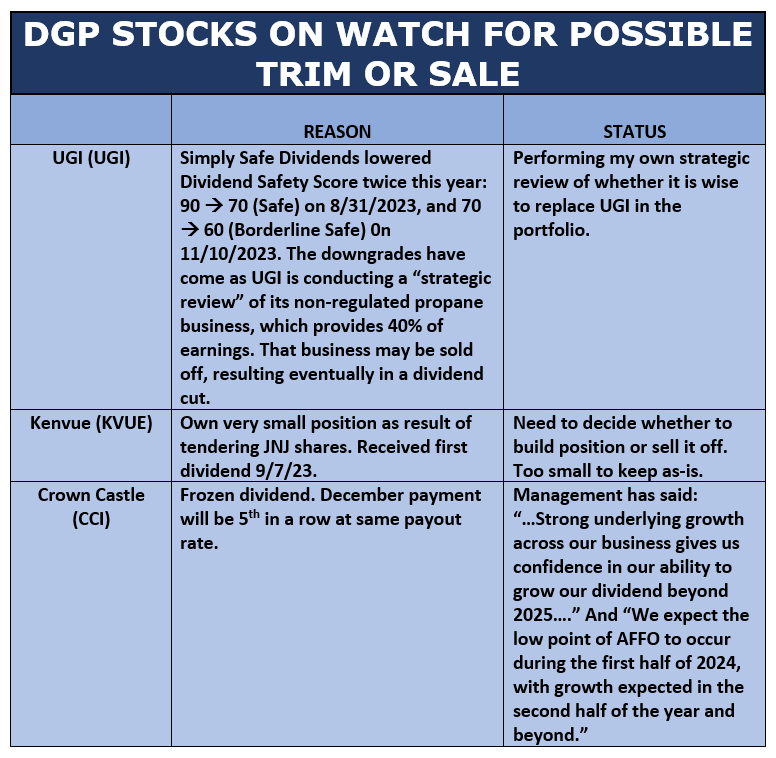 Income Growth Record
Income Growth Record